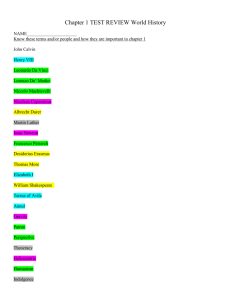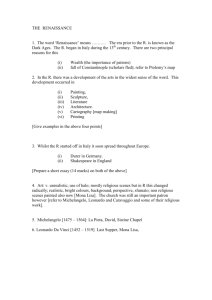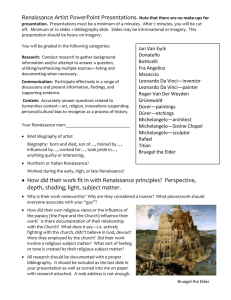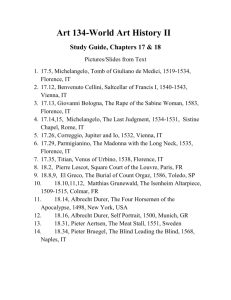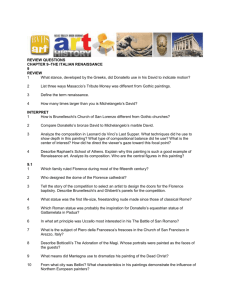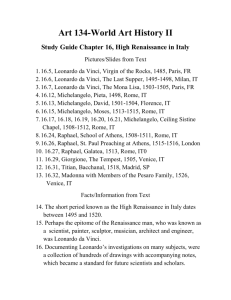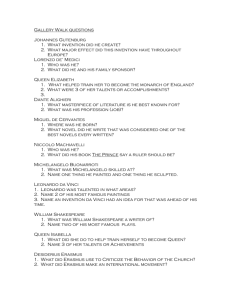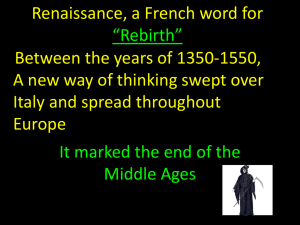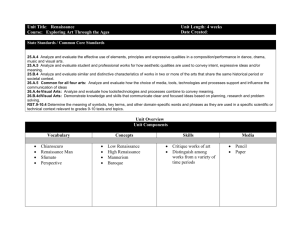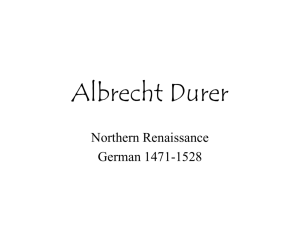The Symbiotic Relationship of Religion and Art
advertisement
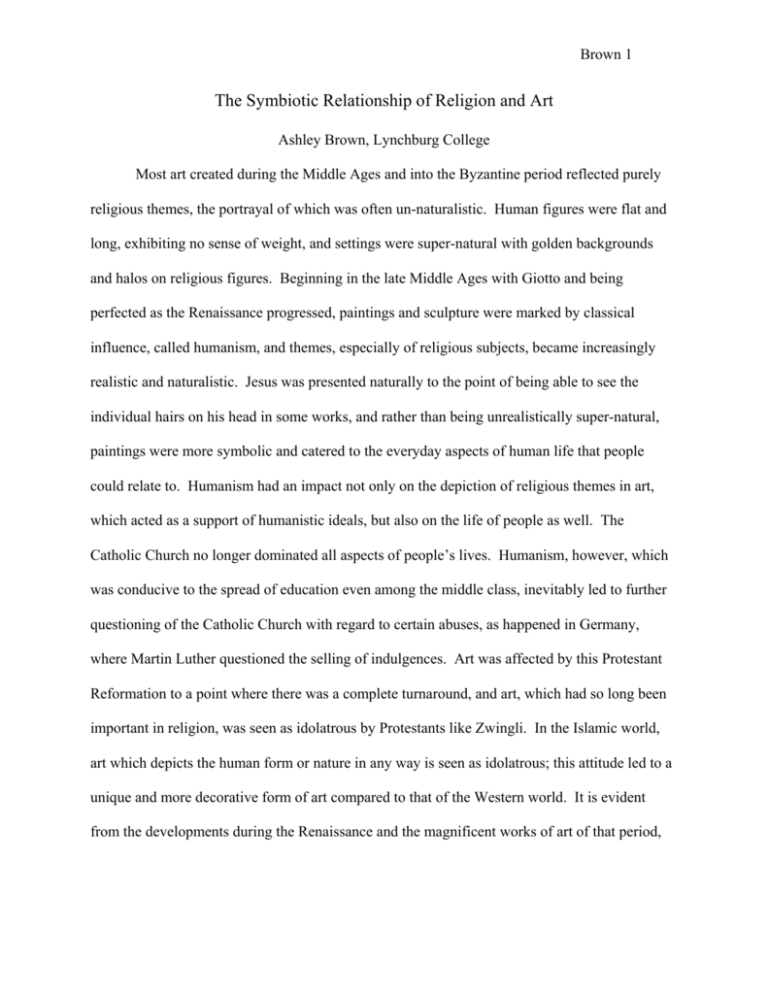
Brown 1 The Symbiotic Relationship of Religion and Art Ashley Brown, Lynchburg College Most art created during the Middle Ages and into the Byzantine period reflected purely religious themes, the portrayal of which was often un-naturalistic. Human figures were flat and long, exhibiting no sense of weight, and settings were super-natural with golden backgrounds and halos on religious figures. Beginning in the late Middle Ages with Giotto and being perfected as the Renaissance progressed, paintings and sculpture were marked by classical influence, called humanism, and themes, especially of religious subjects, became increasingly realistic and naturalistic. Jesus was presented naturally to the point of being able to see the individual hairs on his head in some works, and rather than being unrealistically super-natural, paintings were more symbolic and catered to the everyday aspects of human life that people could relate to. Humanism had an impact not only on the depiction of religious themes in art, which acted as a support of humanistic ideals, but also on the life of people as well. The Catholic Church no longer dominated all aspects of people’s lives. Humanism, however, which was conducive to the spread of education even among the middle class, inevitably led to further questioning of the Catholic Church with regard to certain abuses, as happened in Germany, where Martin Luther questioned the selling of indulgences. Art was affected by this Protestant Reformation to a point where there was a complete turnaround, and art, which had so long been important in religion, was seen as idolatrous by Protestants like Zwingli. In the Islamic world, art which depicts the human form or nature in any way is seen as idolatrous; this attitude led to a unique and more decorative form of art compared to that of the Western world. It is evident from the developments during the Renaissance and the magnificent works of art of that period, Brown 2 which have had a profound influence on art since then, that humanism, religion, and art have long had a symbiotic and volatile relationship. During the Renaissance, humanism pioneered a focus on the individual, which had for so long been generally ignored, and also broke away from the restraints of the Middle Ages through the secularization of works, especially religious works. During the sixteenth century, the realism and careful craft that went into painting, especially in northern Europe and Italy with the artistengineers like Leonardo da Vinci, are staggering. In his Notebooks, da Vinci defends the art of painting as surpassing “all human works” through its portrayal of the philosophy of nature because it is a “subtle invention which with philosophical and ingenious speculation takes as its theme all the various kinds of forms, airs, and scenes, plants, animals, grasses and flowers, which are surrounded by light and shade.” 1 The sciences and especially philosophy became increasingly important in humanist education during the Renaissance, and da Vinci exhibits this trait along with the importance of religion. His Virgin of the Rocks perfectly encompasses all these elements; Leonardo stresses that only painting can portray and gives us an extremely realistic and deep portrayal of the Virgin, the Christ child, the infant John the Baptist, and an angel, all connected to each other in some way through their gestures. Perhaps the painting also allows for a connection between the viewer of and the figures in the painting as Christ and the angel gaze beyond and outside the sight-line of the Virgin and John. Perhaps what also helps the viewer connect to this religiously themed work is the astonishing naturalism of the portrayal of the landscape. The plants and rocks are very detailed and the use of chiaroscuro, modeling in light and dark, illustrates and deepens the naturalism and psychology of the painting. 1 Leonardo da Vinci, Notebooks from Lynchburg College Symposium Readings (Lynchburg College), 493. Brown 3 2 There are no halos of light around the heads of these figures as was seen in art of the Middle Ages, but there is symbolism in their gestures, which completes the naturalistic but also spiritual air of the work. As was seen by the large number of indulgences being bought from the Catholic Church and of course by the numerous religious works created during the Renaissance, religion became 2 Leonardo da Vinci, Virgin of the Rocks (c. 1485), Web Gallery of Art, http://www.wga.hu/framese.html?/html/d/durer/1/10/5_4holy.html. Brown 4 increasingly important even compared to the religiously dominated society of the Middle Ages and the Byzantine era. More people were now becoming educated and taking an active stance on and concern for their personal salvation through faith. In the Renaissance, pagan classical texts were considered for the purpose of illustrating the importance of education and moral philosophy even though these works were not based on Christian ideals. The church could no longer take advantage of widespread ignorance as much as it had before because more people were becoming educated. The Reformation further allowed and inspired the common people of Europe to question and strengthen their inner spiritual faith. In October, 1517, the professor and former monk Martin Luther posted his ninety-five theses about the abuses of the Catholic Church; his criticisms, especially of the selling of indulgences, quickly sparked the Protestant Reformation. Various Protestant groups, such as Luther’s followers and the Anabaptists, began to focus, very true to humanist values, on an inward spirituality and a personal interpretation of faith as they sought to reform or to break away from the Roman Catholic Church. Art was greatly affected by and had an effect on this Reformation, as evidenced by the heavy symbolism and opinion in paintings by artists like Albrecht Durer. Albrecht Durer, an early supporter of Martin Luther, argued that salvation came through grace and faith alone based on the direct teachings of the Bible; Durer opposed the buying of indulgences as the means to clear one’s sins through the church establishment itself. Brown 5 3 He symbolically portrayed his beliefs in his painting Four Apostles, a strikingly naturalistic portrayal of Peter, John, Paul, and Mark. More importantly, this work is filled with deep expression of the new reformist beliefs of Luther and other Protestant leaders. John the Evangelist and Saint Peter appear on the left-hand side of the panel placed so that John is in front of Peter, who represents the Catholic Church. On the right are the Evangelists Mark and Paul. John and Peter read from the Bible, which is open at John’s gospel in the New Testament. It looks as if John is sharing the Bible with Peter, undoubtedly emphasizing that the only source of religious truth is from the word of God, not the Catholic Church. In the work and at the bottom of the panels, Durer uses Luther’s German translation of the Bible to quote passages from each Apostle. The extreme naturalism with which the four Apostles are portrayed has an almost psychological effect on the viewer in that, like other naturalistic religious-themed works of the 3 Durer, Albrecht, The Four Apostles, 1526, Alte Pinakothek, Munich, Web Gallery of Art, http://www.wga.hu/frames-e.html?/html/d/durer/1/10/5_4holy.html (accessed November 10, 2007) Brown 6 Renaissance, the viewer can relate to these figures as real people, not just as men from the Bible who may have previously had no individual faces. It is significant that this painting, which was presented to the city of Nuremberg in Germany, a key city in the development of the Reformation, aims to assist the viewer in effectively identifying with Durer’s Protestant beliefs and faith. In his poem “The Course of My Long Life” from the mid-1500s, Michelangelo laments his life committed to the creation of art, proclaiming, “The impassioned fantasy, that, vague and vast, Made art an idol and a king to me, Was an illusion, and but vanity.” Now Michelangelo feared the judgment of his soul upon his death, saying, “The soul now turning to the Love Divine, That oped, to embrace us, on the cross its arms.” 4 He was referring to Jesus Christ’s crucifixion and sacrifice for the salvation of humankind. 5 Just as Michelangelo referred to art as an idol which led him to stray from true spiritual faith through religion, some radical reformers, such as Ulrich Zwingli in Switzerland, 4 Michelangelo Buonarroti, “The Course of My Long Life” from Lynchburg College Symposium Readings (Lynchburg College), 372. 5 Michelangelo Buonarroti, Creation of Adam, 1510, the Sistine Chapel ceiling, http://www.puzzlehouse.com/images/webpage/creationofman.jpg (accessed November 10, 2007) Brown 7 condemned religious art in his followers’ churches as idolatrous. During the Renaissance, Michelangelo himself created religious works of art as symbolic expressions of deep faith, such as the Creation of Adam, representing the direct connection between man and God. Though perhaps not intended as such, this work supports Lutheran and Reformist ideals about man’s direct relationship with God or about the need to attempt to establish one. The naturalistic portrayal of both Adam and God makes this relationship more comprehensible for believers though this idea may not have been Michelangelo’s intention. This work also supports Luther’s concept of predestination, in which God chooses whether or not to grant certain human beings the privilege of faith. God’s knowledge of the destiny of mankind is shown in the presence of God around the Virgin, Jesus, and other prominent religious figures yet to be born into the world. In today’s society, religion still plays a prominent and important role to some individuals, but life, at least in the United States, is no longer dominated by it. Therefore, there is not a great amount of religious art present in today’s society. It is due to the significant influence of the Church during the Middle Ages that art developed such illuminating religious themes, and it is due in part to the creation of the religiously themed art of the Renaissance that some people developed such deep reactions to spirituality, exemplifying the symbiotic relationship of religion and art. Bibliography Brown 8 Buonarroti, Michelangelo, “The Course of My Long Life.” Excerpted in Shaping Truth: Culture, Expression, and Creativity. Lynchburg College Symposium Readings. Vol. III. Ed. Barbara Rothermel. 3rd ed. USA: Xlibris, 2005. 372-373. Buonarroti, Michelangelo, Creation of Adam. 1510. Sistine Chapel, Rome. http://www.puzzlehouse.com/images/webpage/creationofman.jpg (accessed November 10, 2007). Da Vinci, Leonardo, “Notebooks.” Excerpted in Shaping Truth: Culture, Expression, and Creativity. Lynchburg College Symposium Readings. Vol. III. Ed. Barbara Rothermel. 3rd ed. USA: Xlibris, 2005. 489-495. Da Vinci, Leonardo, Virgin of the Rocks. 1480s. Louvre, Paris. Web Gallery of Art, http://www.wga.hu/index1.html (accessed November 10, 2007). Durer, Albrecht, The Four Apostles. 1526. Alte Pinakothek, Munich. Web Gallery of Art, http://www.wga.hu/frames-e.html?/html/d/durer/1/10/5_4holy.html (accessed November 10, 2007).
